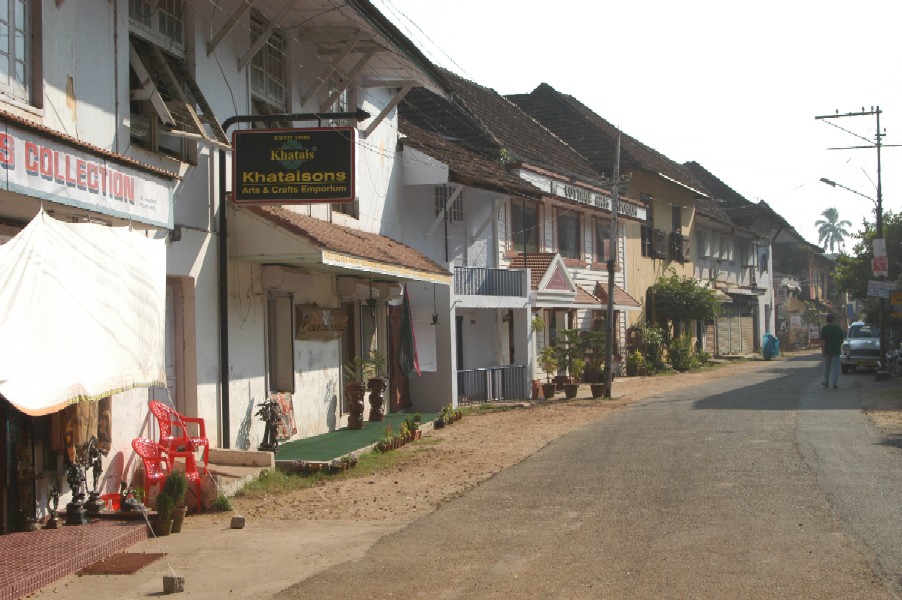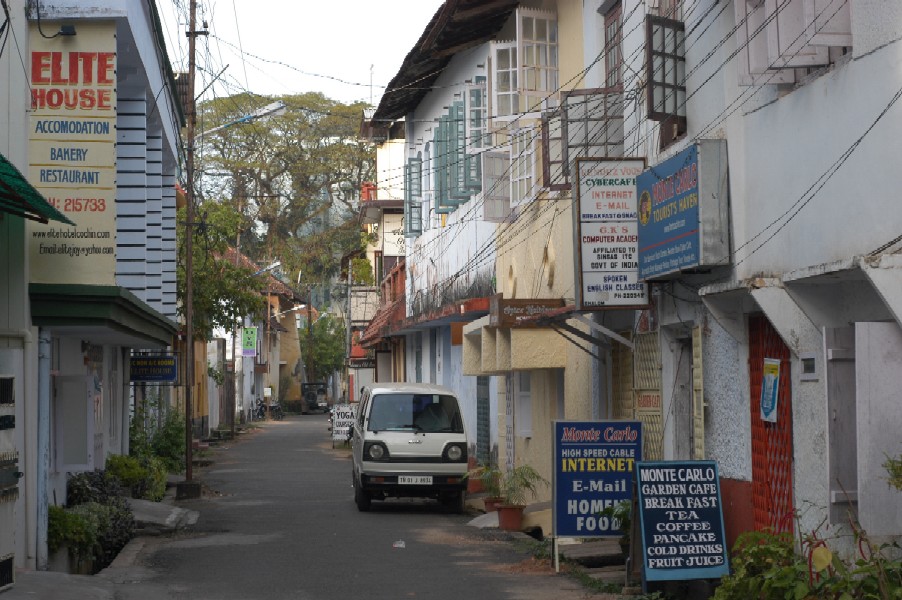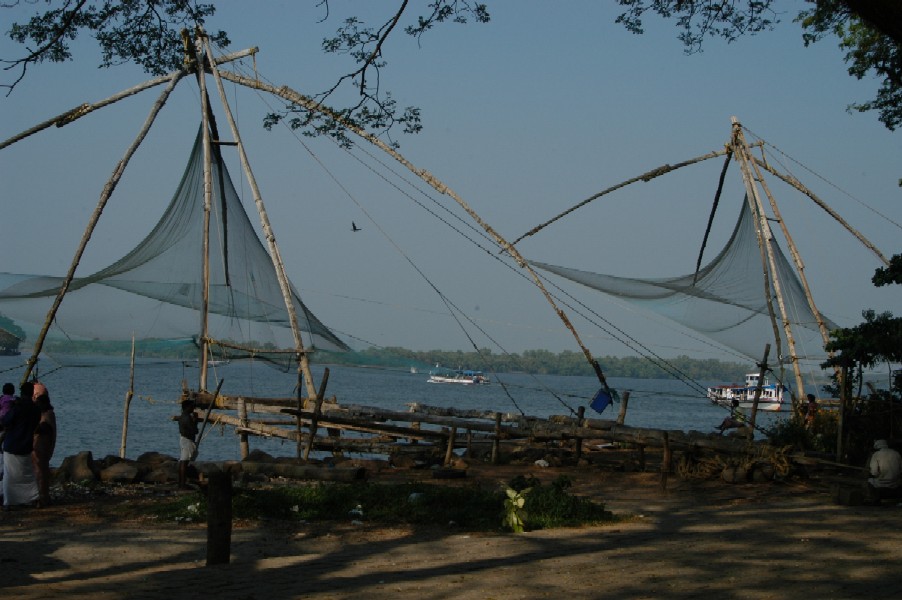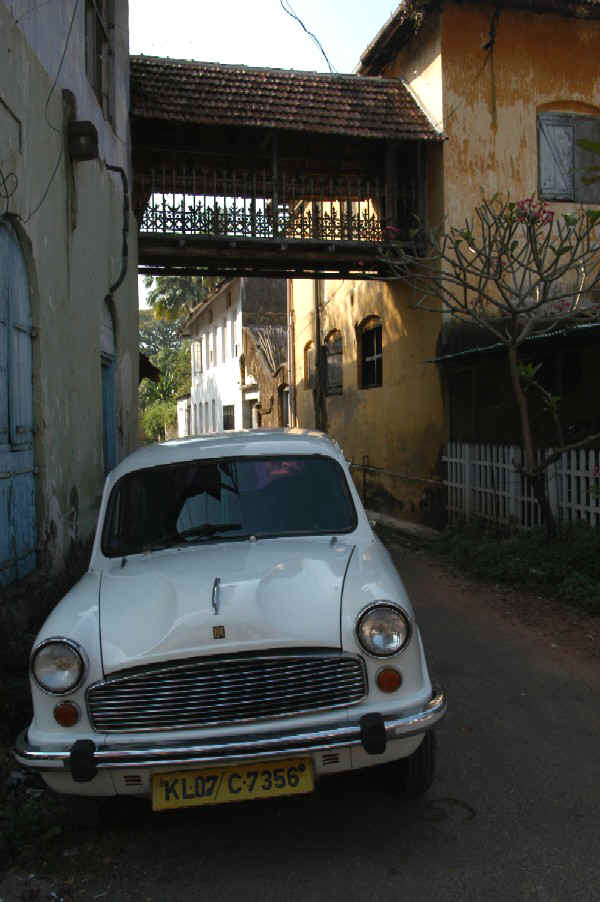November 9 - 15. KOCHI (ERNAKULUM) (continued)The fact that Ernakulum was so easy and comfortable made it easy to stay as long as we did. I doubt any of the hotel or cafe staff expected us to stay so long. We just kept extending and extending until it had been  over a week. I wasn't feeling that great when we arrived and it just turned out to be a great place to start our travels in India and build up some energy. I don't think that I had a genuine bug or anything but I was just totally exhausted. We didn't even leave the hotel and Coffee Beanz much the first few days except to walk around the nearby streets to look for books and to make a trip over to Citibank for money. Finally, after three of four days, we started to get ourselves into gear and make plans for what to do next. over a week. I wasn't feeling that great when we arrived and it just turned out to be a great place to start our travels in India and build up some energy. I don't think that I had a genuine bug or anything but I was just totally exhausted. We didn't even leave the hotel and Coffee Beanz much the first few days except to walk around the nearby streets to look for books and to make a trip over to Citibank for money. Finally, after three of four days, we started to get ourselves into gear and make plans for what to do next.
The old Fort Cochin, across the bay from Ernakulum, was a charming little area with a bizarre melding of many historical elements. It was definitely a more touristy spot but we still didn't encounter much in the way of hassles. Kerela's coastline, the Malabar coast, has had various international influences throughout history and Fort Cochin reflected many in its architecture and monuments. The oldest church in India stood on the far side of the tiny peninsula, the St. Francis Church. In was constructed in 1503 by the Portugese and was the original burial place for Vasco da Gama until his remains were removed to Lisbon. The surrounding homes in Fort Cochin and neighboring Mantancherry reflected the areas Portuguese roots as well as the subsequent Dutch and English influences. The area also had a small Jewish quarter and some mosques. It was very eclectic. The tree covered streets and historical buildings made for some nice exploring. Along the tip of the peninsula there was a dramatic row of cantilevered Chinese fishing nets, the most interesting attraction for many tourists. People would sit in small seafood snack bars and cafes along the waterfront while they watched the massive nets carefully lower into the water for the daily catch. The nets were introduced by traders during the time of the Mughal ruler, Kublai Khan.
We spent several days wandering around Fort Kochin, taking in the various curio and antique shops as well as perusing the well stocked little English bookstore, Idiom. We bought several books at the Idiom Bookshop and they packaged up our new books alo ng with a stack of old books that we wanted to unload and shipped them to the US for a very nominal fee. Packaging things for book rate in India is a bit of an event so it was well worth it. There were a couple of good cafes in Fort Cochin as well, including one that served a great omelet breakfast. And we spent hours in the local internet cafe. The lodgings in Fort Cochin were definitely more quaint than Ernakulum but for the money you got much less. If budget hadn't been an issue we would have stayed at the The Malabar House, a lovely boutique hotel in a restored historical home. But, at $150+/night it was beyond us. ng with a stack of old books that we wanted to unload and shipped them to the US for a very nominal fee. Packaging things for book rate in India is a bit of an event so it was well worth it. There were a couple of good cafes in Fort Cochin as well, including one that served a great omelet breakfast. And we spent hours in the local internet cafe. The lodgings in Fort Cochin were definitely more quaint than Ernakulum but for the money you got much less. If budget hadn't been an issue we would have stayed at the The Malabar House, a lovely boutique hotel in a restored historical home. But, at $150+/night it was beyond us.
On the eastern side of the Fort Cochin peninsula, near the old Jewish quarter, was the Mattancherry Palace museum. It came highly recommended so we had a tuk tuk take us over. He tried to detour us into curio shops along the way but we threatened to get out. The area around the museum was more densely packed with people selling curios, praying on the bus loads of tourists that visited the museum, so it wasn't our favorite part of Fort Cochin but it was a colorful little neighborhood. The old palace was built by the Portuguese in 1555 but was renovated by the Dutch in 1663 so was also called the Dutch Palace. As a building it wasn't very interesting but the murals on the walls throughout were outstanding. Recalling legendary stories from the Ramayana and Mahabharata they were brightly painted from floor to ceiling. The stories of these two Hindu epics reach far and wide in their regional influence, as far as Thailand and even down to Indonesia. The Ramayana, composed around the 3rd to 2nd century BC, tells the story of how Prince Rama, an incarnation of Lord Vishnu, won the hand of Princess Sita, became heir to the throne, and was exiled. His lovely Sita was stolen away to the island of Lanka (Sri Lanka) by the demon king, Ravana, and Rama, with the help of the monkey god Hanuman, saved his princess, killed the demon king and returned to rule from his own kingdom in Ayodhya. The Mahabharata, thought to have been written in the first millennium BC, focuses on Krishna. Over time it became the world's longest work of literature, eight times longer than the Iliad and Odyssey combined! Perhaps the most memorable image in the museum was the one of Krishna lying with his group of milkmaids, all six hands and both feet occupied with fondling the milkmaids in unmentionable areas.
India is a predominantly Hindu (82% of more than a billion) country but the largest minority religion is Islam (12%). There are about 18 million Sikhs, concentrated in the northwest, seven million Buddhists, a small number for the home of Buddha's enlightenment, and four million Jains, another indigenous region. And, for a western religion, there is a surprising 19 million Christians in India, three-quarters of which live in the south. Christianity was brought to Ind ia by the Portuguese in 1498 and Kerela Christian roots were evident. We arrived in India around the start of Deepavali, a major Hindu holiday, but it was barely noticeable around Ernakulum. The little tea lights that mark the holiday were decorated around the large Taj Malabar hotel and firecrackers could be heard here and there but it was quite clear that the holiday wasn't such a big deal in this part of India. That was a bit disappointing for a us initially but it ultimately just helped up realize what a cultural distinctive region we were traveling in. It also meant they were okay with eating beef, which made Rob especially happy. ia by the Portuguese in 1498 and Kerela Christian roots were evident. We arrived in India around the start of Deepavali, a major Hindu holiday, but it was barely noticeable around Ernakulum. The little tea lights that mark the holiday were decorated around the large Taj Malabar hotel and firecrackers could be heard here and there but it was quite clear that the holiday wasn't such a big deal in this part of India. That was a bit disappointing for a us initially but it ultimately just helped up realize what a cultural distinctive region we were traveling in. It also meant they were okay with eating beef, which made Rob especially happy.
The old ferries that plied the bay between Ernakulum, Fort Cochin, and Willingdon Island were a lovely way to travel around the area. It took about fifteen minutes to cross from Ernakulum to Fort Cochin and once the boat got moving there was a nice breeze to keep the heat down. Some of the boats were nicer than others but they were all pretty similar and generally pretty well worn. They reminded me a bit of a smaller version of the ferries that cross the bay in Hong Kong but these were even more simple and not quite a well maintained. The engine was in the middle and rows of bench seats ran the full length of the boat. The area near the entrance always filled up with bicycles or peoples goods. For the locals it was just the regular way of getting around. I always found it relaxing, watching the water surging in or out of the bay, depending on the time of day. The current caused the the green vegetation that grew along the top of the water to bob vigorously. The only thing about the ferries that I didn't really like much were the extra passengers at night. Actually they were there all of the time but just decided to come out at night, the cockroaches. Since we were always wearing sandals I just tried to keep my feet up off of the floor.
As it approached a week in Ernakulum we started to organize our onward plans. Our plans about where to travel around India seemed to change almost hourly. It was such a huge country and there was so much to see that it was hard to pick what to see but we knew that we liked the south so we were definitely going to visit the neighboring state of Tamil Nadu. We were also still toying with the idea of going to the Maldives and went as far as to check into tickets until we read about some islands off the coast of India called Lakshadweep. Like the Maldives the islands were predominantly atolls and the people were mostly Muslim. The main language was Malayalam, the same as Kerela, but people on the southern most island of Minicoy spoke Mahl,the language of the Maldives. The islands were far less developed than the Maldives but that appealed to us. There was a five day trip that departed from Willingdon Island, in the bay between Fort Cochin and Ernakulum. We had visited the island to indulge in a drink at the high-rise Taj Malabar Hotel. The trip went by overnight ferry out and back but the islands looked beautiful and the price wasn't too bad. It was a splurge for us but not nearly as expensive as the Maldives. After thinking about it for a day we went back and put a deposit down on a trip leaving in about two weeks. It would give us enough time to make a loop around Tamil Nadu and come back to catch the boat. Minicoy spoke Mahl,the language of the Maldives. The islands were far less developed than the Maldives but that appealed to us. There was a five day trip that departed from Willingdon Island, in the bay between Fort Cochin and Ernakulum. We had visited the island to indulge in a drink at the high-rise Taj Malabar Hotel. The trip went by overnight ferry out and back but the islands looked beautiful and the price wasn't too bad. It was a splurge for us but not nearly as expensive as the Maldives. After thinking about it for a day we went back and put a deposit down on a trip leaving in about two weeks. It would give us enough time to make a loop around Tamil Nadu and come back to catch the boat.
Beyond those plans we still weren't sure what India had in store for us. We could go northwest towards Agra and through Mumbai and Rajasthan or we could go northeast through Kolkata and up to Darjeeling and Sikkim. Either route would take time and then there was a whole more to consider in the middle. We also knew that we just might be too tired to do any of that and we occasionally thought about just heading to Thailand and hitting the beaches. We would just have to wait and see how we felt after Tamil Nadu.
We went to Ernakulum Junction station to get tickets to Madurai, in Tamil Nadu, before we made the down payment on our Lakshadweep trip. The reservation process was a bit time consuming because the lines were long but it was pretty easy overall. Rob jumped in line while I asked for the train info at the inquiry window and confirmed seat availability on the computerized scheduling system. It took some elbowing to get in there and reach the the inquiry window and get my time at the computer screen but people weren't that pushy. The line moved along slowly but we didn't see people cutting in at the front. In fact, the attendant at the window even chastised a guy he suspected at having sneaked in. The people working at the station spoke enough English that communicating wasn't a problem either. Train travel in India was starting to get busy so we couldn't get a direct train to Madurai but got a pretty convenient connecting route on the day we wanted to leave. With our train tickets bought and our reservation made for Lakshadweep we put in some extra effort seeing some more of the attractions around Fort Cochin before we left. in. The people working at the station spoke enough English that communicating wasn't a problem either. Train travel in India was starting to get busy so we couldn't get a direct train to Madurai but got a pretty convenient connecting route on the day we wanted to leave. With our train tickets bought and our reservation made for Lakshadweep we put in some extra effort seeing some more of the attractions around Fort Cochin before we left. |
SRI LANKA
Colombo
Oct 25
Oct 26
Oct 27-29
Nuwara Eliya
Oct 30
Oct 31
Kandy
Nov 1-5 (1)
Nov 1-5 (II)
Polonnaruwa
Nov 6
Sigiriya & Dambulla
Nov 7
Colombo
Nov 8
INDIA
Ft.Cochin
Nov 9-15 (I)
Nov 9-15 (II)
Nov 16
Nov 17-18
Madurai
Nov 19
Nov 20
Tiruchirapalli
Nov 21
Nov 22
Nov 23
Chennai
Nov 24
Nov 25-26
Nov 27-28
Ft.Cochin
Nov 29
Lakshadweep
Nov 30-Dec 4 (I)
Nov 30-Dec 4 (II)
Trans-India Train
Dec 5-7 (I)
Dec 5-7 (II)
Siliguri
Dec 8
Darjeeling
Dec 9
Dec 10-13
Dec 14
Sikkim
Dec 15
Dec 16-20
Dec 21-23
Dec 24
Dec 25
Darjeeling
Dec 26
Dec 27-Jan 2
Siliguri
Jan 3
Jaigon
(Bhutan)
Jan 4
Kolkata
Jan 5-6
THAILAND
Bangkok
Jan 6-13 (I)
Jan 6-13 (II)
Jan 6-13 (III)
|

